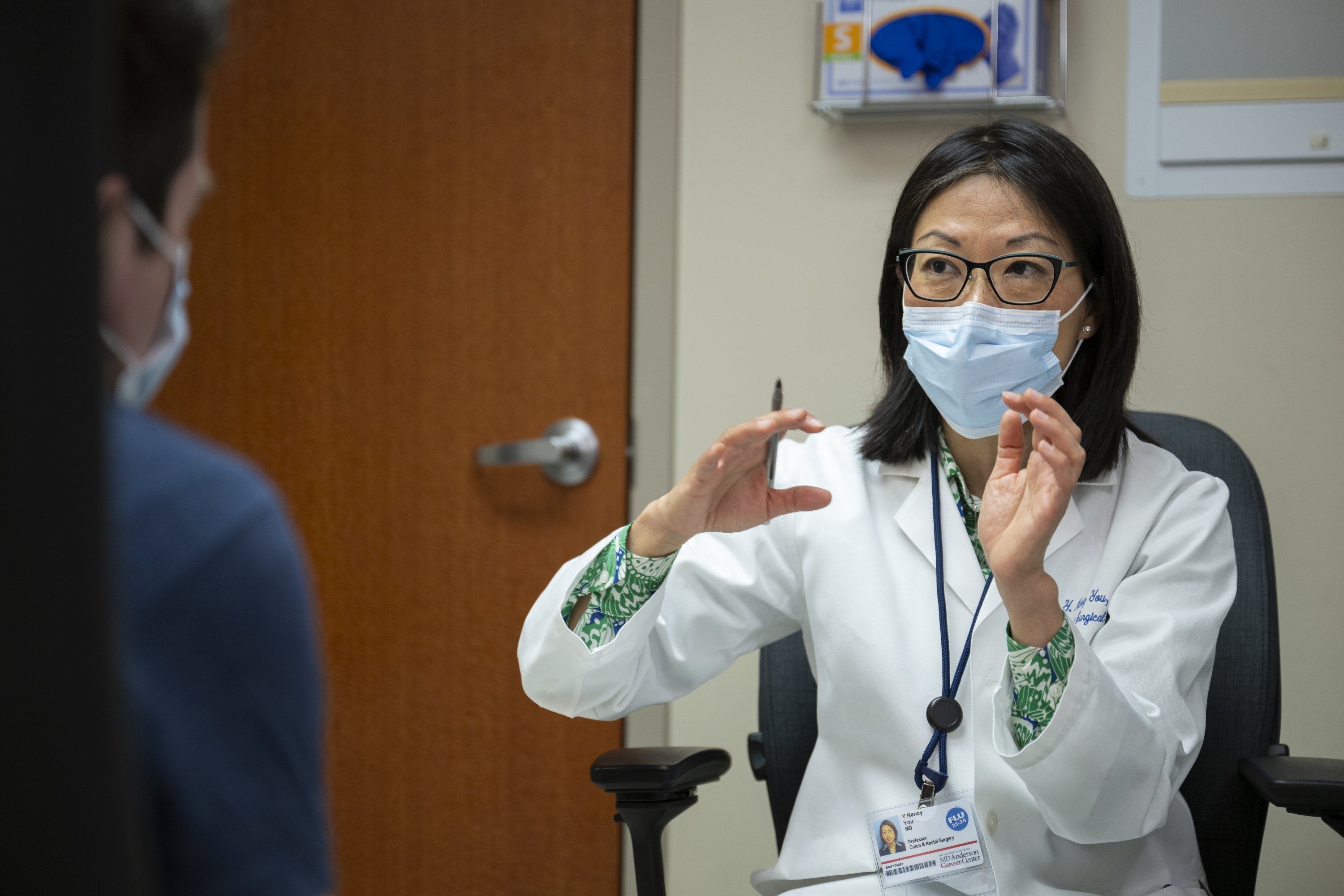- Diseases
- Acoustic Neuroma (14)
- Adrenal Gland Tumor (24)
- Anal Cancer (68)
- Anemia (2)
- Appendix Cancer (16)
- Bile Duct Cancer (26)
- Bladder Cancer (72)
- Brain Metastases (28)
- Brain Tumor (232)
- Breast Cancer (714)
- Breast Implant-Associated Anaplastic Large Cell Lymphoma (2)
- Cancer of Unknown Primary (4)
- Carcinoid Tumor (8)
- Cervical Cancer (158)
- Colon Cancer (166)
- Colorectal Cancer (118)
- Endocrine Tumor (4)
- Esophageal Cancer (44)
- Eye Cancer (36)
- Fallopian Tube Cancer (8)
- Germ Cell Tumor (4)
- Gestational Trophoblastic Disease (2)
- Head and Neck Cancer (12)
- Kidney Cancer (128)
- Leukemia (342)
- Liver Cancer (50)
- Lung Cancer (286)
- Lymphoma (278)
- Mesothelioma (14)
- Metastasis (30)
- Multiple Myeloma (100)
- Myelodysplastic Syndrome (60)
- Myeloproliferative Neoplasm (6)
- Neuroendocrine Tumors (16)
- Oral Cancer (100)
- Ovarian Cancer (172)
- Pancreatic Cancer (160)
- Parathyroid Disease (2)
- Penile Cancer (14)
- Pituitary Tumor (6)
- Prostate Cancer (146)
- Rectal Cancer (58)
- Renal Medullary Carcinoma (6)
- Salivary Gland Cancer (14)
- Sarcoma (238)
- Skin Cancer (296)
- Skull Base Tumors (56)
- Spinal Tumor (12)
- Stomach Cancer (64)
- Testicular Cancer (28)
- Throat Cancer (92)
- Thymoma (6)
- Thyroid Cancer (98)
- Tonsil Cancer (30)
- Uterine Cancer (80)
- Vaginal Cancer (16)
- Vulvar Cancer (20)
- Cancer Topic
- Adolescent and Young Adult Cancer Issues (20)
- Advance Care Planning (10)
- Biostatistics (2)
- Blood Donation (18)
- Bone Health (8)
- COVID-19 (362)
- Cancer Recurrence (120)
- Childhood Cancer Issues (120)
- Clinical Trials (632)
- Complementary Integrative Medicine (22)
- Cytogenetics (2)
- DNA Methylation (4)
- Diagnosis (232)
- Epigenetics (6)
- Fertility (62)
- Follow-up Guidelines (2)
- Health Disparities (14)
- Hereditary Cancer Syndromes (126)
- Immunology (18)
- Li-Fraumeni Syndrome (8)
- Mental Health (116)
- Molecular Diagnostics (8)
- Pain Management (62)
- Palliative Care (8)
- Pathology (10)
- Physical Therapy (18)
- Pregnancy (18)
- Prevention (918)
- Research (392)
- Second Opinion (74)
- Sexuality (16)
- Side Effects (604)
- Sleep Disorders (10)
- Stem Cell Transplantation Cellular Therapy (216)
- Support (402)
- Survivorship (322)
- Symptoms (182)
- Treatment (1786)
Familial adenomatous polyposis monitoring, Whipple procedure gave my husband more time
BY Laura Laster
3 minute read | Published January 24, 2018
Medically Reviewed | Last reviewed by an MD Anderson Cancer Center medical professional on January 24, 2018
When he was 15, my husband Jesse underwent a colectomy, a procedure that removed his colon. Jesse opted to do this after learning that he had familial adenomatous polyposis (FAP), a genetic condition that caused him to develop polyps throughout his gastrointestinal tract and put him at increased risk for colorectal cancer.
Fifteen years later, a routine endoscopy showed that Jesse had a lot of polyps in his abdominal area. We needed to see a specialist. At a family member’s recommendation, we came to MD Anderson to see Dr. Patrick Lynch.
Familial adenomatous polyposis, then a colorectal cancer diagnosis
Up until that point, Jesse and I thought his colon removal would prevent him from developing cancer. However, Dr. Lynch explained that Jesse’s continued polyp growth meant he was still at high risk for colorectal cancer. We returned to MD Anderson every six months for a new endoscopy, and over the years, Jesse’s condition worsened.
This past summer, the pathology report on a polyp removed from his duodenum showed high-grade dysplasia, meaning the polyp looked more abnormal – and more like cancer. Dr. Lynch immediately sent us to Dr. Matthew Katz, who said Jesse needed to undergo a Whipple procedure, a surgery to remove his gallbladder, duodenum as well as a part of his pancreas and stomach.
Jesse’s Whipple procedure
Dr. Katz explained that Jesse’s surgery would be riskier than most because his pancreas was healthy, which made it prone to leakage and fluid buildup, increasing his risk for an infection. To avoid any surprises, Dr. Katz prepared for surgery by performing a CT scan to identify scar tissue from Jesse’s previous procedures and create a roadmap for the surgery.
On Nov. 30, 2017, about a month and a half after Jesse’s 35th birthday, he underwent the 5-hour surgery without complications. His first week of recovery was difficult. He couldn’t eat or drink anything, and he had a nasal tube that made him feel uncomfortable. But Jesse was determined to begin his last semester of school on time, so we did everything our care team recommended. We started walking laps around the floor, and we tried to set a record every day because we were told that walking around helped people heal faster.
By Dec. 11, Jesse was able to eat solid foods again. He was discharged two days later, but then he developed an infection from the fluid buildup about which Dr. Katz had warned us. Jesse was re-admitted on Dec. 14 and remained in the hospital for another six days.
Even though we were disappointed that we couldn’t make it home for Christmas, we were thankful that his situation wasn’t worse. Jesse continued to show daily improvements, and by the time we left Houston on Jan. 2, he was barely taking any medications, including painkillers. And he was well enough to start the semester on time.
Gratitude for MD Anderson – and more time
Jesse and I cannot say enough good things about MD Anderson and the care he received on the P10 nursing unit after surgery. Dr. Katz once told us he wanted to do the surgery so Jesse could spend another 50 years with our family. We’re cautiously optimistic that will be the case.
Request an appointment at MD Anderson online or by calling 1-833-997-1856.
Related Cancerwise Stories

Jesse and I can't say enough good things about MD Anderson.
Laura Laster
Caregiver





